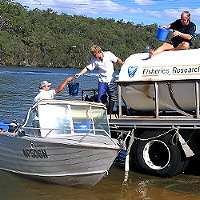Hatchery fish are going well . . . and wild

(PhysOrg.com) -- Young mulloway fish reared in hatcheries and released in New South Wales waters are adapting quickly and well to life in the wild, a new study has found.
Led by Dr Matthew Taylor from the University of New South Wales and in collaboration with NSW Department of Industry and Investment, the stocking program involves the release of fingerlings of the popular fish and subsequent monitoring. The research is funded jointly by the NSW Recreational Saltwater Fishing Trust and the Australian Research Council.
The project aims to develop mulloway stock enhancement to boost recreational fishing opportunities, and Dr Taylor and colleagues are following the progress of the released fish to better understand the impacts of their release into NSW estuaries.
Working with an environmental scientist with the Australian Nuclear Science and Technology Organisation, Dr Debashish Mazumder, Dr Taylor has examined what the released fish are eating and how quickly they adapt to a diet similar to that of wild fish.
They found that hatchery-reared fish rapidly adopt the diets of wild fish, a finding that suggests the hatchery fish have settled in well and are behaving much like their wild cousins.
The technique involves sampling muscle tissue of captured fish and analysing carbon and nitrogen stable isotopes. That allows the researchers to accurately trace the dietary sources used by both kinds of fish - a big improvement on a less reliable method of sampling stomach contents, which provided only a partial snapshot of the diet.
In a paper published recently in the journal Marine and Freshwater Research, the researchers report that the isotopic composition of the released fish was distinct from wild fish until 200 days after release, meaning that released fish rapidly adapt to their new diet and surroundings. The findings will help to refine stocking strategies for mulloway in NSW estuaries.
Wild mulloway (Argyrosomus japonicus) are apex predators in southern Australian estuaries, growing to about 1.5 metres long and weighing up to 70 kilograms. Overfishing has brought into question the sustainability of the fishery.
The stocking program aims to enhance recreational fisheries in estuaries where population numbers have been low, such as the Georges River, south of Sydney.
While the fingerlings released so far appear to be doing well, the viability of the stocking program will not be clear until scientists have more information about the contribution of released fish to the recreational fishery.
Provided by University of New South Wales


















